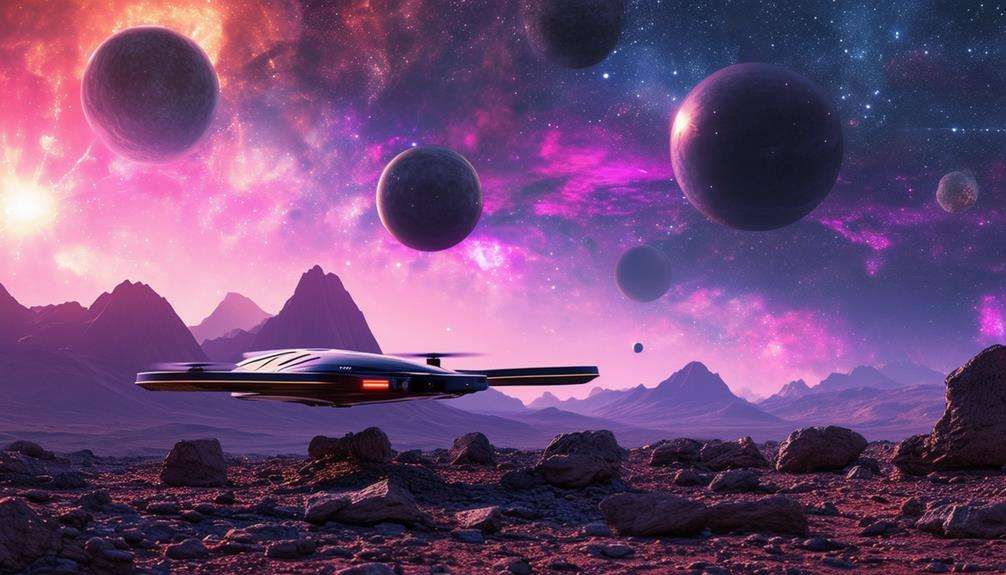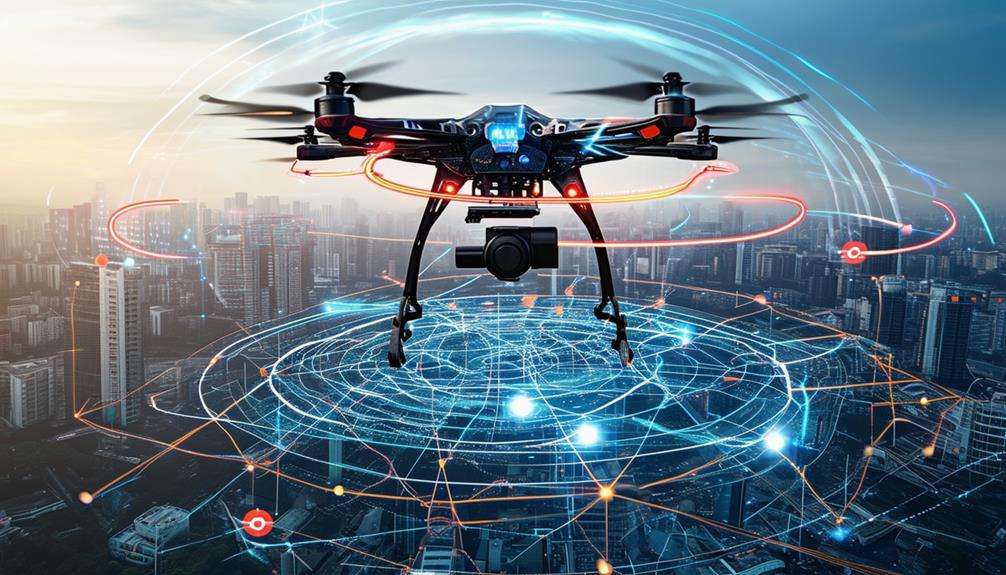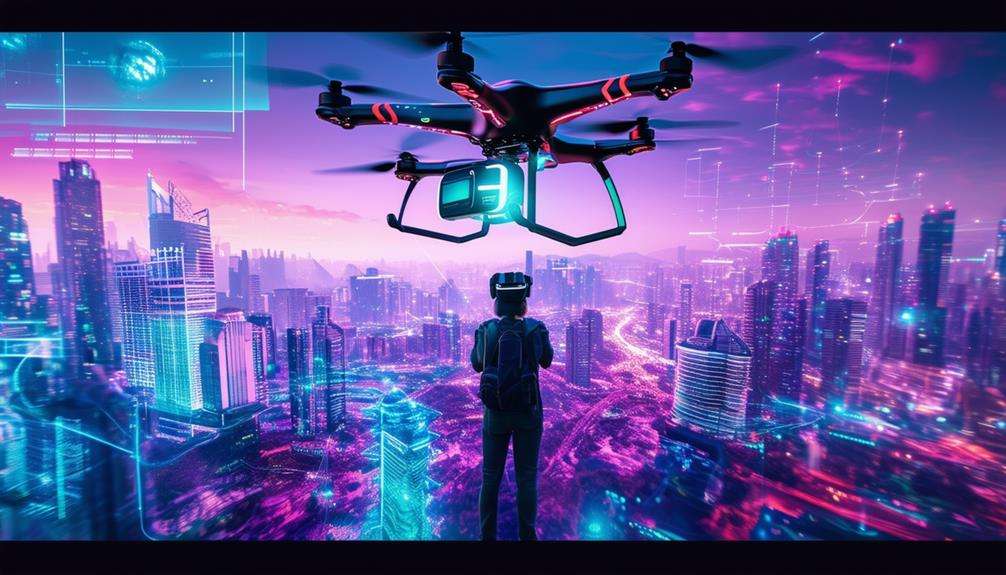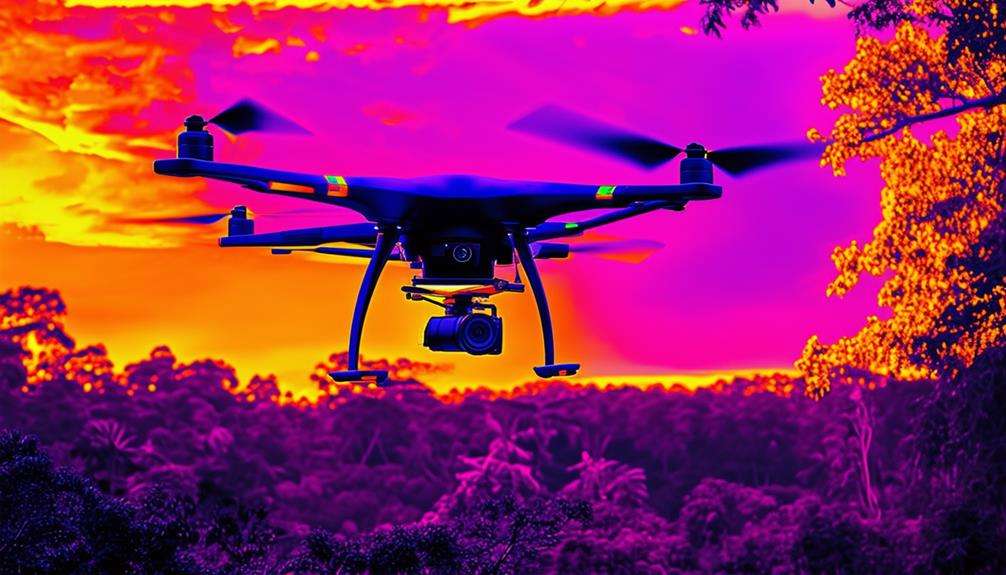The Role of UAVs in Space Exploration: The Next Frontier for Drones
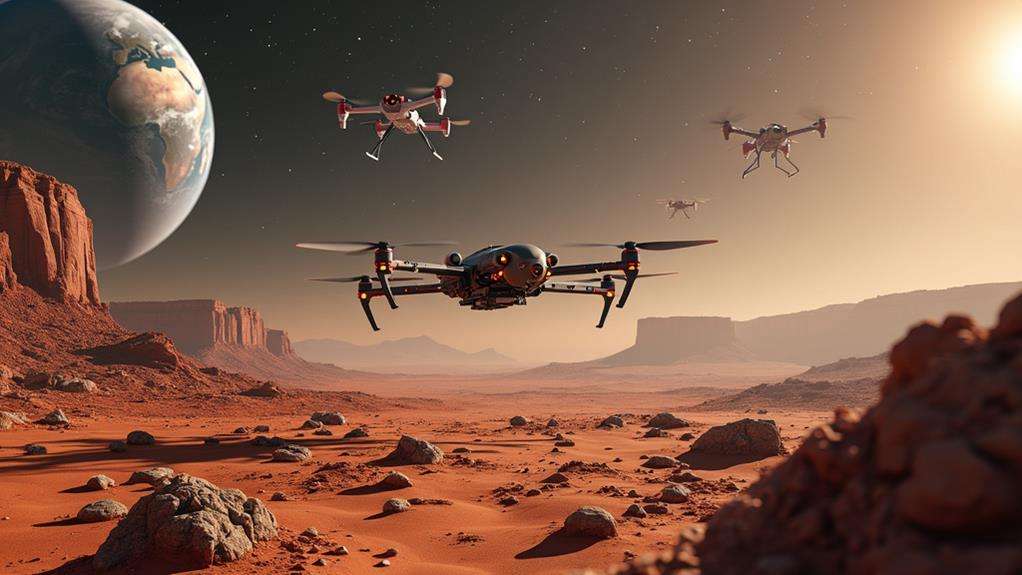
Imagine UAVs transforming space exploration by taking on critical roles in missions. Drones could perform detailed inspections at launch facilities, execute autonomous spacecraft repairs, and gather samples from remote planetary surfaces. These advanced capabilities enhance safety, cut costs, and reduce dependency on Earth-based support. As technology evolves, UAVs will be indispensable for long-term space missions. Want to know how these drones could reshape the future of space travel?
UAVs in Launch Facilities
Unmanned Aerial Vehicles (UAVs), commonly known as drones, are transforming operations at launch facilities. Equipped with high-resolution cameras, these drones efficiently inspect spacecraft storage areas and hangars for structural damage and leaks, ensuring the integrity of these valuable assets.
Drones are also pivotal in conducting safety inspections. They monitor debris and assess real-time weather conditions, providing critical data that aids in launch decision-making. This real-time monitoring ensures that decision-makers have the most current information, enhancing the safety and success of each mission.
Advanced sensors on drones can detect electrical faults, contributing to the overall safety and readiness of launch vehicles. These sensors enable more efficient and thorough inspections of complex launch sites, reducing the risk of overlooked critical issues.
Integrating drones into launch facility operations streamlines processes by reducing human error and improving pre-launch check efficiency. With enhanced maintenance and monitoring capabilities, drones help ensure that every aspect of the launch facility is in optimal condition, leading to safer and more successful launches.
Autonomous Spacecraft Repairs
Autonomous drones capable of repairing spacecraft represent a significant advancement in space technology, extending the operational life of missions. Equipped with specialized tools for maintaining critical components such as solar panels and communication antennas, these drones can drastically reduce costs by eliminating the need for frequent resupply missions. This capability not only minimizes downtime but also enhances the efficiency and effectiveness of space exploration, making it a more sustainable endeavor.
Extending Operational Lifetimes
As space missions become increasingly ambitious, extending the operational lifetimes of spacecraft is crucial for their success. Autonomous drones are pivotal in this effort by performing in-space repairs and significantly enhancing mission longevity. Equipped with specialized tools, these drones can autonomously conduct routine maintenance and repairs on critical components like solar panels and communication antennas, reducing dependency on Earth-based support and the need for costly resupply or crewed repair missions.
By handling in-space repairs, autonomous drones lower the overall costs of space exploration while enhancing the functionality and reliability of spacecraft. This enables missions to operate longer, gathering more scientific data over time. For instance, drones can repair a malfunctioning antenna or replace a damaged solar panel without waiting for a crewed mission.
The development of these autonomous repair systems is a crucial step toward sustainable space exploration. It supports continuous operations for long-duration missions, ensuring that spacecraft remain functional and productive well beyond their initial expectations. By extending operational lifetimes, we can push the boundaries of what is possible in space exploration, paving the way for even more ambitious missions in the future.
In-Space Maintenance Tools
Imagine a future where spacecraft can autonomously repair themselves without the need for human intervention. Specialized drones equipped with advanced tools are making this vision a reality. These drones can perform essential in-space repairs, such as fixing solar panels and communication antennas, significantly extending the operational lifetimes of spacecraft.
By conducting routine maintenance tasks, these autonomous drones enhance spacecraft functionality and reduce dependence on Earth for logistical support. This leads to more efficient space missions and enables more ambitious exploration objectives.
Here's how autonomous drones revolutionize spacecraft maintenance:
- Routine Maintenance: Autonomous drones perform regular checks and repairs, ensuring spacecraft systems function optimally.
- Emergency Repairs: In the event of unexpected damage, drones can quickly address issues, preventing major mission disruptions.
- Extended Lifetimes: By repairing critical components like solar panels, drones help spacecraft operate longer, maximizing return on investment.
- Complex Repairs: Future advancements may allow drones to handle more complex repairs, further integrating them into routine spacecraft operations.
With these capabilities, autonomous drones are paving the way for a new era in in-space repairs, making long-term space missions more feasible and efficient.
Cost Reduction Benefits
Autonomous drones conducting in-space repairs offer significant cost savings for space exploration missions. By repairing spacecraft components like solar panels and communication antennas, these drones extend the operational lifetimes of spacecraft. This reduces the need for expensive and logistically complex resupply missions from Earth.
By autonomously managing routine maintenance tasks, drones enhance spacecraft functionality without human intervention. They enable quicker responses to maintenance issues, which is crucial for missions in remote or hostile environments. This capability substantially lowers the overall costs of space exploration, making long-duration missions more financially viable.
Moreover, employing autonomous drones for spacecraft repairs fosters innovative designs and solutions, which can further decrease costs associated with traditional maintenance methods. Reducing reliance on Earth-based repairs not only saves money but also boosts operational efficiency, thereby increasing the likelihood of mission success.
Planetary Exploration
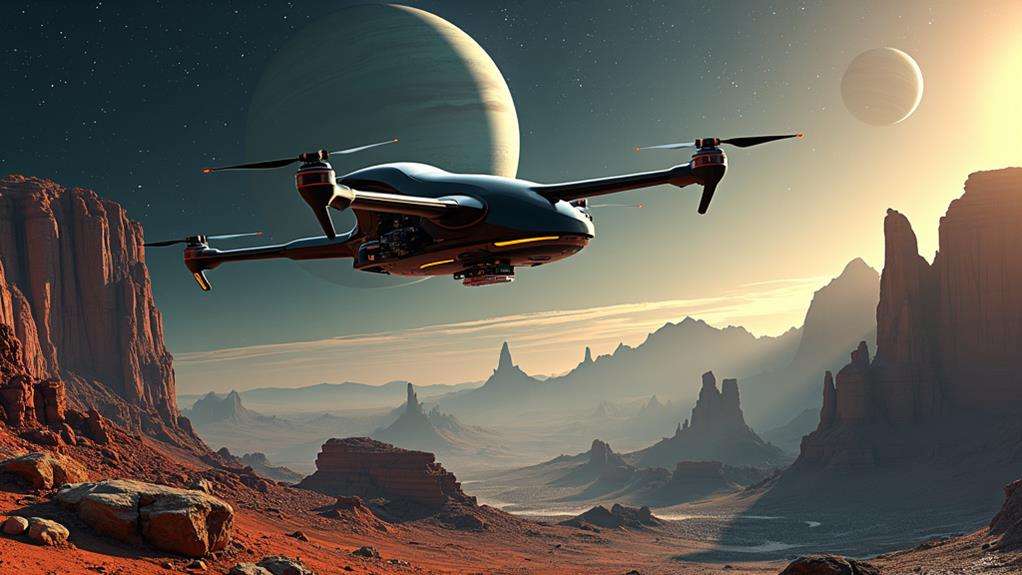
When considering planetary exploration, drones like the Mars Helicopter Ingenuity are prime examples, demonstrating advanced aerial imaging capabilities on Mars. These autonomous drones not only capture high-resolution visuals but also have the potential to collect samples from extraterrestrial terrains, enabling significant scientific breakthroughs. Equipped with sophisticated navigation and communication technologies, drones can access previously unreachable areas, enhancing mission efficiency and cost-effectiveness.
Autonomous Sample Collection
In recent years, the use of drones for autonomous sample collection in planetary exploration has opened new frontiers in space science. By employing sophisticated autonomous systems, drones can now efficiently gather samples from extraterrestrial locations, making planetary exploration far more effective and comprehensive. These drones significantly enhance the scope of scientific analysis, enabling researchers to study the geology and composition of planets with unprecedented detail.
Consider these benefits of autonomous sample collection:
- Extended Reach: Drones can access areas that rovers cannot, providing a more thorough understanding of a planet's geological diversity.
- Continuous Operation: Equipped with autonomous systems, drones can operate independently, collecting data and samples without the delays associated with Earth-based control.
- In Situ Analysis: Future missions may allow drones to analyze samples on-site, reducing the need to return materials to Earth for study.
- Feasibility Proven: The Mars Helicopter, Ingenuity, has already demonstrated the practicality of aerial sample collection by identifying optimal sampling sites through high-resolution imagery.
Aerial Imaging Capabilities
Aerial imaging capabilities have revolutionized planetary exploration, providing unparalleled insights into the geological and atmospheric conditions of extraterrestrial environments. Drones equipped with high-resolution cameras capture detailed images of planetary surfaces, significantly enhancing geological analysis and aiding in site selection for future missions. For instance, the Mars Helicopter, Ingenuity, has successfully taken thousands of images, delivering crucial data on Martian terrain and atmosphere.
In addition to capturing stunning visuals, drones autonomously collect and analyze samples from inaccessible locations on celestial bodies, transforming data collection methods. This is vital for mapping geological features and studying atmospheric conditions, which offer insights into climate patterns and the potential habitability of other planets. Unlike rovers, drones can access areas such as deep craters and steep cliffs, broadening the scope of exploration.
Here's a visual representation of these ideas:
| Feature | Benefit |
|---|---|
| High-resolution cameras | Enhanced geological analysis |
| Mars Helicopter (Ingenuity) | Critical data on terrain and atmosphere |
| Autonomous sample collection | Study of planetary compositions |
| Mapping capabilities | Insights into climate and habitability |
| Access to hard-to-reach areas | Expanded exploration and data collection |
Lunar Resource Utilization
Harnessing lunar resources is revolutionizing space exploration, with drones playing an indispensable role. Unmanned aerial vehicles (UAVs) are at the forefront of this initiative, making it feasible to identify and utilize essential resources like water ice, helium-3, and rare minerals. Leveraging UAV technology, detailed resource surveys are conducted, which are crucial for the success of future lunar missions.
Using drones for preliminary mining activities significantly reduces mission costs by relying on local resources instead of costly shipments from Earth. This efficiency is transformative for space missions. UAVs are making an impact in several key areas:
- Resource Surveys: UAVs identify and map valuable lunar resources.
- Cost Reduction: Utilizing local materials reduces the need for Earth-based supplies.
- Infrastructure Development: Drones transport materials and equipment to build habitats and power systems.
- Sustainable Colonization: Drone-assisted resource management supports long-term human presence on the Moon.
Interstellar Exploration
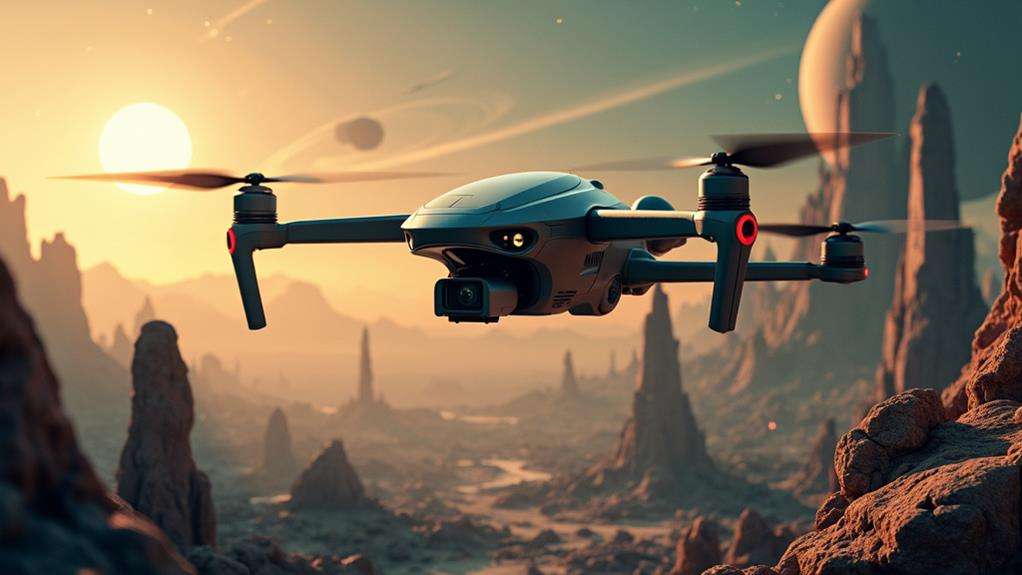
In the domain of interstellar exploration, drones are at the forefront of autonomous deep-space surveys, tackling vast distances with advanced propulsion systems. Initiatives like Breakthrough Starshot aim to send these nimble crafts to Alpha Centauri, equipped with sensors to detect biomarkers and potential signs of life. Leveraging their autonomous capabilities, these drones can operate independently, gathering crucial data far beyond our solar system.
Autonomous Deep-Space Surveys
Drones are revolutionizing interstellar exploration with their autonomous capabilities, allowing them to operate independently in deep-space environments. Imagine lightweight drones being deployed to Alpha Centauri as part of missions like Breakthrough Starshot, traveling at 20% of the speed of light. These drones can conduct deep-space surveys autonomously, gathering crucial data without direct control from Earth, thus eliminating communication delays.
Equipped with advanced sensors, these drones can survey asteroids and other celestial bodies, providing valuable data for potential resource extraction and mining operations. Here's how:
- Resource Identification: Drones can pinpoint locations rich in minerals and other resources, enabling targeted exploration and extraction.
- Environmental Analysis: They can assess the composition, temperature, and other vital parameters of asteroids, aiding in the selection of suitable targets.
- Cost-Effective Exploration: Utilizing drones for various surveys reduces the financial and human risks associated with manned missions.
- Advanced Propulsion Systems: Future designs may include advanced propulsion systems like solar sails or nuclear thermal propulsion, enhancing their reach and efficiency.
These advancements ensure that interstellar exploration is more efficient, safe, and economically viable.
Advanced Propulsion Systems
Advanced propulsion systems are pivotal for the ambitious goal of interstellar exploration. By utilizing cutting-edge technologies such as gas or water vapor propulsion, the performance of unmanned aerial systems (UAS) for deep-space missions can be significantly enhanced. Lightweight drone designs, equipped with these powerful propulsion systems, are essential for achieving the incredible speeds required for missions like Breakthrough Starshot, which aims to reach Alpha Centauri at 20% the speed of light.
NASA is currently exploring various propulsion concepts, including electric and hybrid systems, to improve maneuverability and endurance during long-duration space missions. These systems must operate efficiently in the vacuum of space, addressing the unique challenges posed by deep-space conditions. Integrating advanced propulsion technologies will expand the operational capabilities of drones, enabling them to perform complex tasks in distant celestial environments.
| Propulsion Type | Key Benefits |
|---|---|
| Gas Propulsion | High thrust, efficient for short bursts |
| Water Vapor Propulsion | Sustainable, suitable for long-duration |
| Electric/Hybrid Systems | Enhanced maneuverability and endurance |
With these advanced propulsion systems, the frontier of space exploration will be broadened, pushing the boundaries of what's possible with unmanned aerial systems.
UAV Capabilities in Space
Frequently, standard UAVs face significant challenges when transitioning from Earth's atmosphere to the vacuum of space. To make this leap, UAVs need substantial modifications. Traditional drones can't operate in low atmospheric pressure environments without these customizations. However, specialized propulsion systems are being developed to enable UAVs to function effectively in space. These advancements are crucial for space exploration, paving the way for innovative missions.
To enhance UAV capabilities in space, consider these key modifications:
- Propulsion Systems: Custom propulsion systems are essential for maneuvering in the vacuum of space. Traditional propellers are ineffective in such conditions, so alternative methods like ion thrusters or cold gas propulsion are required.
- Weather Balloons: UAVs can utilize weather balloons to reach operational heights, overcoming the limitations of standard lift capabilities in low atmospheric pressure regions.
- Durability: Advanced UAVs must be constructed to endure extreme planetary conditions, ensuring functionality during long-duration missions.
- Autonomy: Research is ongoing to develop drones capable of performing complex tasks autonomously, such as sample collection and repairs.
These modifications are critical to ensuring UAVs can effectively contribute to space exploration and carry out missions beyond Earth's atmosphere.
NASA Innovations
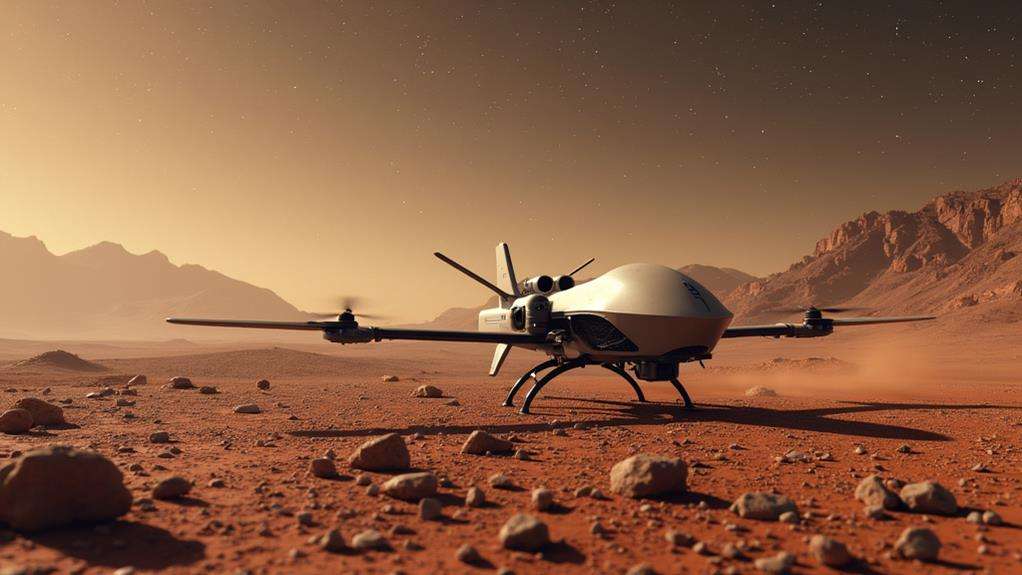
How has NASA revolutionized the use of UAVs in space exploration? By leveraging cutting-edge drone technology, NASA has set new benchmarks for crewless missions beyond Earth. A prime example is the Mars Helicopter, Ingenuity, which made history in April 2021 with its 39.1-second flight. This mission provided invaluable aerial data, confirming that drones could operate in extraterrestrial environments.
NASA's X-37B Orbital Test Vehicle further exemplifies the potential of UAVs in space. This versatile spacecraft undertakes crewless missions to test new technologies and gather critical data on space environments. These missions have proven that drones can successfully execute complex tasks without human intervention, paving the way for future explorations.
To support these advancements, NASA is actively researching innovative propulsion systems suitable for space. Concepts like gas and water vapor propulsion are being explored to enhance drone efficiency and longevity. These innovations could revolutionize how drones navigate and perform in the harsh conditions of space.
Moreover, NASA's Mars Sample Return mission will utilize drones to collect rock samples, underscoring the practical applications of UAV technology in planetary exploration. By focusing on safety and performance, NASA ensures that its drone designs maintain structural integrity in extreme conditions, pushing the boundaries of what's possible in space exploration.
Cost-Effectiveness of Drones
Drones offer a cost-effective solution for space exploration by significantly reducing expenses associated with transportation, safety, and operational logistics. Their autonomous capabilities allow them to handle in-space repairs and maintenance, thereby minimizing the need for costly human intervention and making long-term missions more financially viable.
Key points highlighting the cost-effectiveness of drones include:
- Preliminary Mining Activities: Drones can perform initial mining and resource surveys on celestial bodies, eliminating the high costs of sending human crews.
- Aerial Exploration: Using drones for aerial exploration and data collection minimizes the need for multiple expensive rovers. Drones can cover larger areas more efficiently, reducing the number of missions required.
- Local Resource Utilization: Drones can utilize local resources for construction and infrastructure development, significantly reducing the financial burden of transporting materials from Earth.
- Autonomous Maintenance: Drones' autonomous capabilities enable them to conduct repairs and maintenance in space, avoiding the high costs and risks associated with sending astronauts for these tasks.
Drones in Harsh Environments
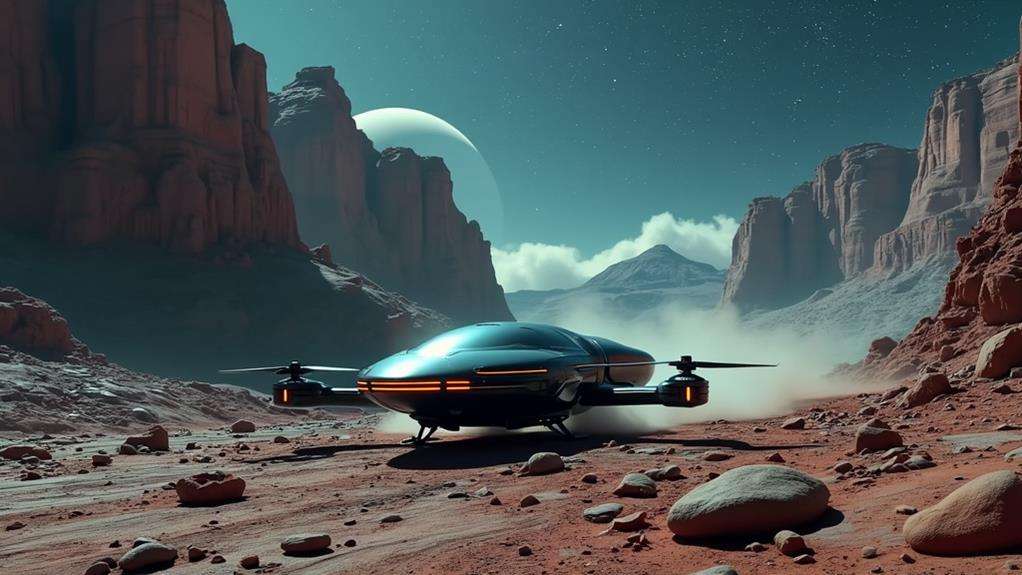
Leveraging the cost-effectiveness of drones in space exploration, their capability to operate in harsh environments significantly enhances their utility. Outfitted with advanced sensors and high-resolution cameras, drones can efficiently maneuver through extreme extraterrestrial conditions to inspect spacecraft and planetary surfaces. These drones must withstand temperature variations from extreme heat to freezing cold, necessitating robust thermal management systems to protect sensitive components such as batteries and sensors.
In the Martian atmosphere, characterized by low pressure and frequent dust storms, specialized designs and propulsion systems are essential. These features enable drones to maintain flight and operational efficiency despite the challenging conditions. Autonomous drones excel at navigating inaccessible terrains on celestial bodies, overcoming obstacles such as rugged landscapes and adverse weather that impede traditional exploration methods.
Ongoing research focuses on developing lightweight materials and innovative designs to enhance drone performance and durability. Utilizing advanced sensors and cutting-edge technology, these drones can perform critical tasks that are unfeasible for human explorers or conventional machinery. In essence, drones in harsh environments unlock new frontiers for space exploration, allowing us to uncover and understand the universe's most inhospitable regions.
Future of Space Drones
Imagine a future where drones outfitted with advanced propulsion systems, such as gas and water vapor technologies, traverse the vast expanses of space, undertaking tasks that once seemed impossible. These space drones will revolutionize extraterrestrial exploration by leveraging sophisticated propulsion to navigate diverse environments. Enhanced by AI integration, they will autonomously make decisions, improving operational efficiency.
Future space drones will excel in several critical areas:
- Complex Operations: They will handle intricate tasks like drilling and conducting in-situ experiments, significantly expanding the scope of planetary missions.
- Interstellar Missions: Initiatives such as Breakthrough Starshot aim to deploy lightweight drones to Alpha Centauri, equipped with advanced sensors to detect biomarkers in exoplanet atmospheres.
- Enhanced Reliability: Ongoing advancements will make these drones more reliable, efficient, and cost-effective, rendering them indispensable in space exploration.
- Operational Efficiency: AI integration will enhance their decision-making capabilities, increasing their adaptability and success rates in unpredictable space environments.
With these advancements, future space drones will play a pivotal role in exploring the cosmos, pushing the boundaries of what humanity can achieve beyond Earth.

